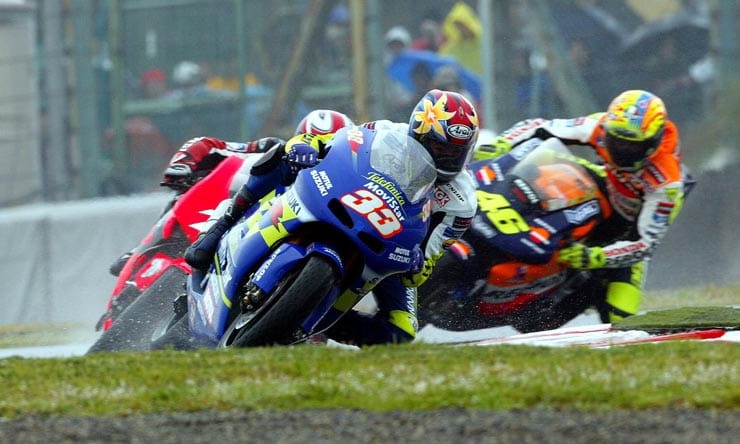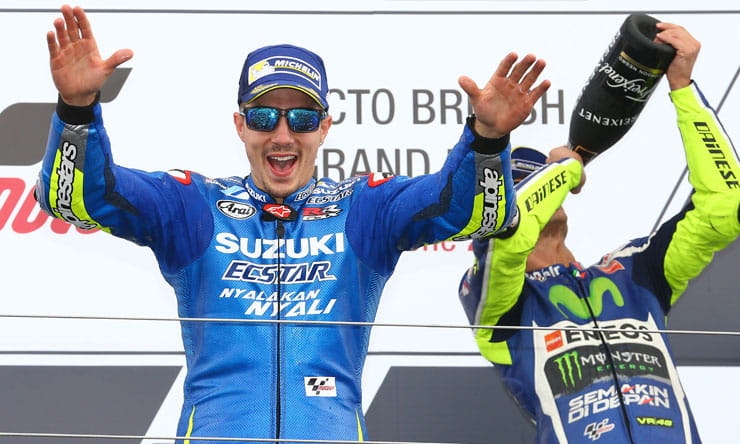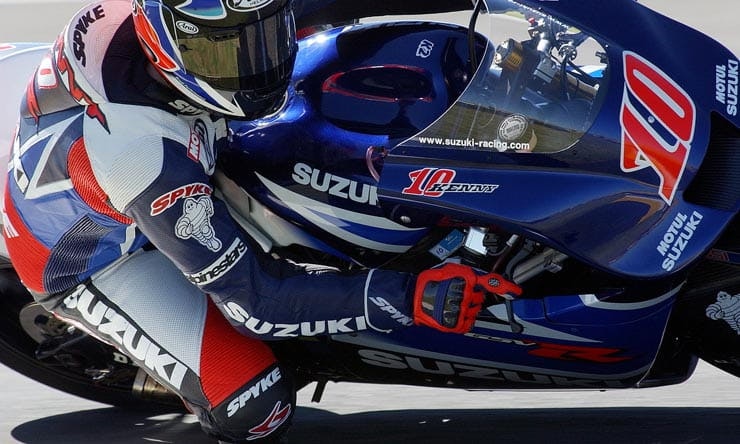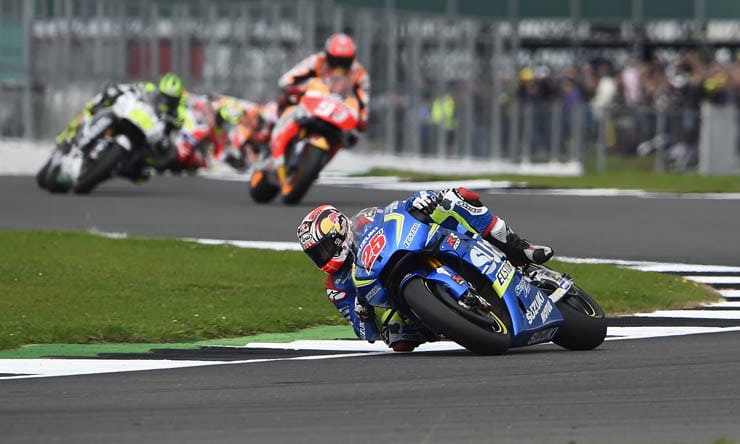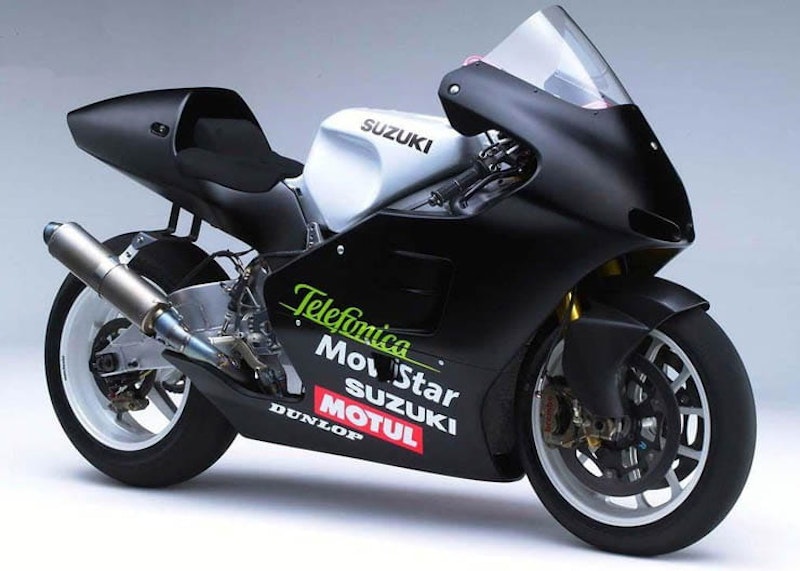With a decade and a half of four-stroke action under its belt MotoGP has firmly established itself as the preeminent road-racing class – shedding its two-stroke irrelevance and becoming a beacon for future technology that quickly filters through to production bikes.
In the fourth part of our series celebrating the 15 years since the four-stroke championship’s emergence, we’re looking at Suzuki’s on-off relationship with the category.
Unlike the series stalwarts, Honda, Yamaha and Ducati, Suzuki left MotoGP once after a long, largely fruitless period. But it almost instantly rethought the decision and started work on a recent comeback that’s already looking more convincing.
Here’s how the firm’s MotoGP effort has evolved.
Gestation of the GSV-R
Suzuki originally planned to delay its entry into MotoGP until 2003, sticking with its old two-stroke RGV500 – which had taken Kenny Roberts Junior to the title in 2000 – during the 2002 transitional year.
However, a combination of weak results for the 500cc stroker and faster-than-expected development of the new four-stroke 990, codenamed XRE0, led to a late change of mind in November 2001. The four-stroke would be made ready for the start of the following year.
The development machine followed the technical layout that many pundits expected to be the favoured one for the new class. It used a V4 – like all the old two-strokes had – which in turn allowed the bike to carry over a general chassis layout that was similar to the earlier bikes.
During its November 2001 reveal, Suzuki claimed it made 210bhp at 14,5000rpm.
2002 GSV-R (XRE0)
The first-generation race bike, having been brought into action a year earlier than expected, was basically identical to the development machine from 2001.
Aside from mild changes to the fairing, seat unit and exhaust, the bike’s tech was the same as the machine shown in November the previous year. Retaining the XRE0 codename of the prototype, it was given the official title GSV-R to tie it in with the GSX-R road bike series. The V was to emphasise its V4 engine.
That engine was a 60-degree V, using the full 990cc capacity limit. With fuel injection (not as ubiquitous then as it is today – the old strokers had been carb-fed and Yamaha’s 2002 four-stroke stuck with carbs as well) – the engine was state of the art for the era.
The frame was a straight development from the old RGV500 design, although not identical, and the bike’s styling and aerodynamics were also clearly following the same route as its two-stroke predecessor.
The bike’s results were patchy at best. Second place for Akira Ryo in the season opener brought false hopes, and the XRE0 never ranked so high again. A third in Brazil for Roberts was its only other podium and Suzuki trailed home a distant third in the constructors’ championship behind Honda and Yamaha.
2003 GSV-R (XRE1)
Suzuki originally intended to make 2003 its first four-stroke season, hence the bike’s ‘XRE1’ designation, where the development bike raced in 2002 had been the XRE0.
And on looks alone, it was certainly a big step forwards. There was a completely new chassis, a redesigned engine (now with a 65 degree V-angle) and radical, shovel-nosed styling intended to bring aerodynamic benefits as well. A switch from Dunlop to Michelin rubber should also have given the 2003 bike a stronger chance.
Good on paper, then. But the bike was a dog. Suzuki’s John Hopkins and Kenny Roberts Junior only scraped into the top 10 on a couple of occasions, and in the final tally the team managed less than a third of the points haul it achieved in 2002. That left the factory fifth in the final ratings, with newcomers Ducati and even Aprilia’s much-derided RS Cube ahead of it.
2004 GSV-R (XRE2)
With poor results in 2003, Suzuki made big changes again to its MotoGP bike for the 2004 season. The XRE2 carried over some elements, including the V4 engine, but added a completely redesigned chassis with different geometry and rigidity as well as another new fairing shape.
Although there was still a hint of the shovel-shaped nose, a repositioned air intake was supposed to improve the ram-air effect. The fuel tank was redesigned, moving more of the fuel lower down under the rider’s seat, and the wheelbase was longer.
Once again there was a switch of tyre supplier, with Michelin swapped for Bridgestone.
In terms of results, things didn’t get much better. Suzuki remained fifth in the constructor rankings, beating Aprilia this time but losing out to an improving Kawasaki as well as Honda, Yamaha and Ducati.
2005 GSV-R (XRE3)
If points were doled out based on appearances, Suzuki’s 2005 XRE3 would have been a winner. The new white-dominated colour scheme and the redesigned fairings that switched the odd front end of the previous model for a much sleeker shape made the bike something of a looker.
The fairing shape had actually developed during the 2004 season – by the end of the year the XRE2 looked much like this as well – and the much beefier swingarm was also a development that Suzuki had made during the previous year as it struggled to improve its results.
The continual development would continue during 2005, with the bike gaining new (uglier) fairings with the following year’s triangular air intake as the year wore on.
The bike’s results were depressingly familiar. Although Suzuki managed a second place for Roberts at the British GP, that was its only podium and one of only five forays into the top 10.
2006 GSV-R (XRE4)
As mentioned, by the end of 2005 the pretty XRE3 had been given a nose-job to replace its pretty original face with a more brutal look which continued onto the 2006 XRE4.
While the nose had already been previewed, the rest of the bike was largely new for 2006 as well. Notable changes, along with another revamped frame, were a swingarm that shifted its bracing to below rather than above, following what has become the norm in the class since then.
Other big changes included a new under-seat exhaust for the rear cylinder bank, with pipework hanging low above the rear wheel to clear the fuel tank that was already sited under the seat.
For the last year of the 990s, the Suzuki engine has also evolved, making something in the region of 250bhp by this stage and revving beyond 16,000rpm. At this stage the bike still used conventional valve springs, but pneumatics were under development to push revs even higher.
The results were a little better, but Suzuki didn’t feature much at the sharp end of races in 2006. Best was second for Chris Vermeulen in Australia, but that was the bike’s only podium.
2007 GSV-R (XRG0)
With a new 800cc capacity limit for 2007 we saw big technical changes up and down the grid but Suzuki’s offering actually had rather fewer visual updates than we might have expected.
The new capacity also brought a new ‘XRG’ naming series, returning the bike’s number to zero. It retained the previous year’s design thinking, with the under-seat pipe and small central air intake on the nose, but all the fairing shapes became more refined. It was like the heavily revamped 2006 bike had been a prototype for the 2007 machine.
The engine gained pneumatic valves, which were fast becoming the norm in the 800cc class as manufacturers turned to high revs to claw back power lost to the smaller capacity limit. Peak power now came at 17,500rpm.
On this occasion, the regulation shake-up favoured Suzuki. They got it right when Honda in particular appeared to get it rather wrong.
Both Hopkins and Chris Vermeulen became podium regulars, with the latter getting Suzuki’s first four-stroke MotoGP win in France. The riders ended up fourth and sixth respectively in the title chase, and while Suzuki remained only fourth-best constructor, the gap to Honda, Ducati and Yamaha was much closer than any previous year.
2008 GSV-R (XRG1)
With its best season yet under its belt, Suzuki appeared to be heading the right direction and so the XRG1 was a development of the previous bike’s thinking rather than an out-and-out redesign.
Chassis-wise, the bike started the season with an updated swingarm (which had debuted part way through the previous season) and significant changes to the bodywork. As with several previous Suzukis, the nose shape appeared to be designed to bludgeon its way through the air rather than gently usher it to one side, and the trademark trapezoid air intake remained, albeit upturned on the new fairing.
The 2008 bike’s seat exhibited a different aero concept to previous versions, with a slimmer shape and upswept sides.
By this stage, the pneumatic valve V4’s power was back to around 225bhp, and Suzuki, like all the others on the grid, was heavily into the use of electronics to govern its delivery.
In results terms, the bike slid back a little, probably more the result of Honda improving on 2007’s ill-conceived RC212V and bringing more of its riders to the front than due to Suzuki’s performance slipping back.
Fourth in the constructors’ championship and three podium finishes were Suzuki’s haul for the year.
2009 GSV-R (XRG2)
With its 2009 GSV-R, Suzuki appeared to reverse some of its thinking from the previous year.
The bike’s fairing shapes reverted to ones similar to the 2006 and 2007 models, losing the 2008 bike’s bluff nose and upswept tail in favour of a more visibly aerodynamic-looking slope at the front and a wider, boxy rear with sharp horizontal creases.
What lay beneath was familiar. Suzuki didn’t radically change its engine or chassis design for the new season, again simply refining and tweaking the existing bike’s concepts to try and improve its performance.
Unfortunately, the results suggested that more changes might have been welcome. Ninth place in the championship for Loris Capirossi and 12th for Vermeulen didn’t accurately reflect their abilities.
Suzuki retained fourth in the constructor standings, but had fewer than half the points of third-placed Ducati as the chasm between MotoGP’s haves and have-nots grew wider.
2010 GSV-R (XRG3)
Given the poor showing in 2009, Suzuki’s riders – Capirossi and Alvaro Bautista for 2010 – might have hoped for big changes to the 2010 bike.
They didn’t get them.
Changes for the year were few and far between. With the global financial crisis in full swing Suzuki wasn’t spending as much as its rivals on its MotoGP effort.
There were small visible tweaks to the bodywork and the usual efforts to squeeze out more power and better handling from refinements to the engine and chassis. And of course the suspension and brakes were updated to the latest from Ohlins and Brembo. But it wasn’t enough.
Suzuki’s season was one of retirements and lowly finishes, with Bautista 13th and Capirossi 16th in the championship. As a constructor Suzuki was fourth again, but since Kawasaki had already left the series, fourth was also last.
2011 GSV-R (XRG4)
Suzuki’s 2011 MotoGP effort was half-hearted. A single-bike team for Bautista alone. But that bike – the last in the GSV-R series – actually showed radical changes.
Just looking at the XRG4 for 2011 instantly reveals a completely new chassis design and different thinking when it comes to the swingarm.
Power was simply claimed to be ‘more than 225bhp’ and peaked at 18,000rpm, while the Mistubishi electronics were improved yet again.
In terms of results, the bike performed rather as you might expect for a design that was radically changed from the previous year. In the first half of the year it couldn’t break into the top 10, but during the second half it never finished outside the top 10 as the team got on top of the bike’s behaviour. There were plenty of non-finishes, though, and Suzuki killed its MotoGP effort at the end of 2011, blaming the economic circumstances and leaving the championship with only three factory constructors for 2012 (in turn ushering in the short-lived CRT regulations to help boost the grid).
Gestation of the GSX-RR
Given that Suzuki opted out of MotoGP at the end of 2011, it was a little surprising when an all-black prototype race bike was spied on test in Sugo in early 2012. Its exhaust layout made it clear it was an inline four-cylinder, unlike the previous V4 GSV-R racers, and onlookers claimed it sounded like a crossplane-crank design.
Initially expected to make its race debut in 2014, the new bike was officially revealed in late 2013 under the XRH-1 name, and of course complied with the new 1000cc MotoGP rules rather than the 800cc limit met by the last of the V4 Suzuki racers. However, 2014 was later put aside as a testing year and the bike only raced once, in the last round of the championship, now under the GSX-RR name. With test rider Randy de Puniet on board, it didn’t finish.
2015 GSX-RR
Since its return to MotoGP, Suzuki has dropped the use of separate names for each year’s racers – the new bikes are simply called GSX-RR to reflect well on the GSX-R road bikes that share their inline-four layout.
The lack of year-by-year naming also makes sense given the way Suzuki has approached the bike’s development. Rather than launching a new version for each season, development has been continual. For instance, during 2015, two very different chassis and bodywork designs were used.
One was like the bike shown here – with large holes in the sides of an aluminium beam frame so skimpy that it’s nearly a trellis. The other chassis looked just like the version seen on the 2016 bike below, with a much more solid-looking alloy frame.
The new engine’s secret weapon was a variable valve timing system that sidestepped MotoGP rules intended to ban such designs. The rulebook says that hydraulic or electronic VVT systems are banned, so Suzuki developed a purely mechanical design that uses centrifugal force to alter the valve timing. The new 2017 GSX-R1000 road bike also uses the same system.
In the first year, the GSX-RR was a mid-field machine, much like its predecessor.
2016 GSX-RR
As mentioned, Suzuki is evolving the new GSX-RR gradually rather than going for wholesale year-to-year changes. However, by 2016 the team seemed to have settled on the second of the two frame designs it used in 2015.
Although the firm is very secretive – you’ll rarely find a picture of the GSX-RR with its bodywork off – it appears that the panels in the front edges of the air outlet vents on either side are actually part of the chassis rather than the bodywork. They’re carbon-fibre pieces that bolt to the frame and to the engine, working as engine mounts but also doubling as bodywork and air-guides to vent heat from the radiator.
The bike gained the stock Magneti Marelli standardised ECU for 2016 and gained a seamless-shift transmission to bring it into line with rival works bikes.
With a mercurial newcomer, Maverick Vinales, at the helm, the 2016 bike broke Suzuki’s nine-year losing streak to win the British GP. It was only Suzuki’s second four-stroke victory, the other being France in 2007.
Like every other factory bike, the Suzuki sprouted wings in 2016, only for them to be banned in 2017.
2017 GSX-RR
While the official launch bike for the 2017 season looked virtually unchanged compared to the 2016 design, in testing Suzuki used something rather different.
The test Suzuki featured extensions on either side of the fairing hiding ‘internal’ winglets, or vanes, to guide airflow and try to regain downforce lost with the banning of last year’s wings.
Honda, Yamaha, Aprilia and, most radically, Ducati have also tested variations on the same idea.
